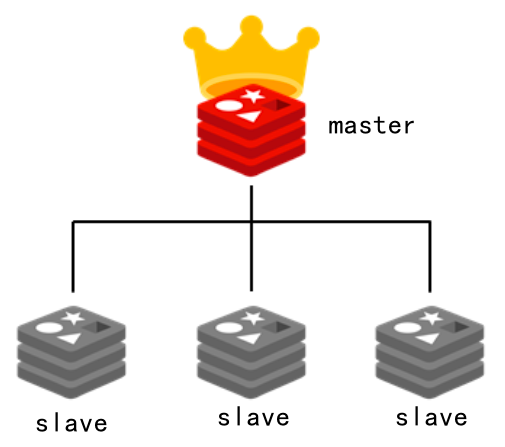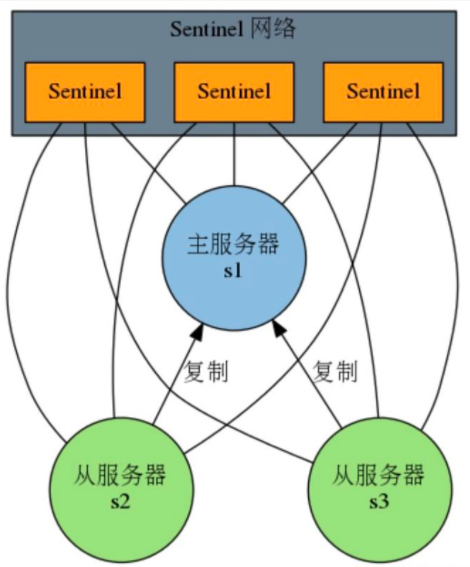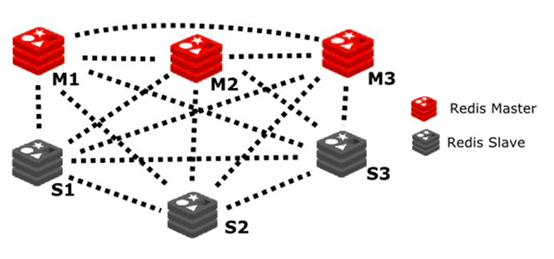Redis master-slave replication
brief introduction
The read-write capability supported by a single redis is still limited. At this time, we can use multiple redis to improve the concurrent processing capability of redis. How these redis cooperate requires a certain architecture design. Here, we first analyze and implement the master / slave architecture
Basic architecture
redis master-slave architecture is shown in the figure below:

Among them, the master is responsible for reading and writing, synchronizing the data to the save, and the slave node is responsible for reading
Quick start practice
Based on Redis, a Master-Slave architecture is designed, including one Master and two Slave. The Master is responsible for reading and writing Redis and synchronizing data to the Slave. The Slave is only responsible for reading, The steps are as follows:
First, duplicate redis01, for example:
cp -r redis01/ redis02
cp -r redis01/ redis03
Step 2: if there are existing redis services, first stop all the original redis services (docker rm -f redis container name) and start a new redis container, for example:
docker run -p 6379:6379 --name redis6379 \ -v /usr/local/docker/redis01/data:/data \ -v /usr/local/docker/redis01/conf/redis.conf:/etc/redis/redis.conf \ -d redis redis-server /etc/redis/redis.conf \ --appendonly yes
docker run -p 6380:6379 --name redis6380 \ -v /usr/local/docker/redis02/data:/data \ -v /usr/local/docker/redis02/conf/redis.conf:/etc/redis/redis.conf \ -d redis redis-server /etc/redis/redis.conf \ --appendonly yes
docker run -p 6381:6379 --name redis6381 \ -v /usr/local/docker/redis03/data:/data \ -v /usr/local/docker/redis03/conf/redis.conf:/etc/redis/redis.conf \ -d redis redis-server /etc/redis/redis.conf \ --appendonly yes
Step 3: check the redis service role
Start the three clients, log in to the three redis container services respectively, and view the roles through the info command. By default, the three newly started redis service roles are master
127.0.0.1:6379> info replication
\# Replication role:master connected_slaves:0 master_repl_offset:3860 repl_backlog_active:1 repl_backlog_size:1048576 repl_backlog_first_byte_offset:2 repl_backlog_histlen:3859
Step 4: check the ip settings of redis6379
docker inspect redis6379
......
"Networks": {
"bridge": {
"IPAMConfig": null,
"Links": null,
"Aliases": null,
"NetworkID": "c33071765cb48acb1efed6611615c767b04b98e6e298caa0dc845420e6112b73",
"EndpointID": "4c77e3f458ea64b7fc45062c5b2b3481fa32005153b7afc211117d0f7603e154",
"Gateway": "172.17.0.1",
"IPAddress": "172.17.0.2",
"IPPrefixLen": 16,
"IPv6Gateway": "",
"GlobalIPv6Address": "",
"GlobalIPv6PrefixLen": 0,
"MacAddress": "02:42:ac:11:00:02",
"DriverOpts": null
}
}
Step 5: set Master/Slave architecture
Log in to redis6380/redis6381 respectively, and then execute the following statement
slaveof 172.17.0.2 6379
Note: if the master has a password, it needs to be in redis.com of the slave Add the statement "masterauth your password" in the conf configuration file, restart redis, and then execute the slave of command
Step 6: log in to redis6379 again and check info
[root@centos7964 ~]# docker exec -it redis6379 redis-cli 127.0.0.1:6379> info replication
\# Replication role:master connected_slaves:2 slave0:ip=172.17.0.3,port=6379,state=online,offset=2004,lag=1 slave1:ip=172.17.0.4,port=6379,state=online,offset=2004,lag=1 master_failover_state:no-failover master_replid:5baf174fd40e97663998abf5d8e89a51f7458488 master_replid2:0000000000000000000000000000000000000000 master_repl_offset:2004 second_repl_offset:-1 repl_backlog_active:1 repl_backlog_size:1048576 repl_backlog_first_byte_offset:1 repl_backlog_histlen:2004
Step 7: log in to redis6379 to test. The master can read and write
[root@centos7964 ~]# docker exec -it redis6379 redis-cli 127.0.0.1:6379> set role master6379 OK 127.0.0.1:6379> get role "master6379" 127.0.0.1:6379>
Step 8: log in to redis6380 to test. slave can only read.
[root@centos7964 ~]# docker exec -it redis6380 redis-cli 127.0.0.1:6379> get role "master6379" 127.0.0.1:6379> set role slave6380 (error) READONLY You can't write against a read only replica. 127.0.0.1:6379>
Read / write test analysis in Java. The code is as follows:
@SpringBootTest
public class MasterSlaveTests {
@Autowired
private RedisTemplate redisTemplate;
@Test
void testMasterReadWrite(){//The profile port is 6379
ValueOperations valueOperations = redisTemplate.opsForValue();
valueOperations.set("role", "master6379");
Object role = valueOperations.get("role");
System.out.println(role);
}
@Test
void testSlaveRead(){//The profile port is 6380
ValueOperations valueOperations = redisTemplate.opsForValue();
Object role = valueOperations.get("role");
System.out.println(role);
}
}
Principle analysis of master-slave synchronization
Redis master-slave structure can adopt one master-slave structure. Redis master-slave replication can be divided into full synchronization and incremental synchronization according to whether it is full or not.
- Redis full synchronization:
Redis full replication usually occurs in the Slave initialization stage. At this time, the Slave needs to copy all the data on the Master. The specific steps are as follows:
1) Connect the slave server to the master server and send the SYNC command;
2) After receiving the SYNC naming, the master server starts to execute the BGSAVE command to generate an RDB file and uses the buffer to record all write commands executed thereafter;
3) After the master server BGSAVE executes, it sends snapshot files to all slave servers, and continues to record the executed write commands during sending;
4) After receiving the snapshot file from the server, discard all old data and load the received snapshot;
5) After sending the snapshot from the master server, start sending the write command in the buffer to the slave server;
6) Loading the snapshot from the server, receiving the command request, and executing the write command from the main server buffer;
- Redis incremental synchronization
Redis incremental replication refers to the process of synchronizing the write operations of the master server to the Slave server when the Slave starts working normally after the Slave is initialized. The main process of incremental replication is that the master server sends the same write command to the Slave server every time it executes a write command, and the Slave server receives and executes the received write command.
Section interview analysis
- What would you do if redis wanted to support 100000 + concurrency?
It's almost impossible for a single redis to say that the QPS exceeds 100000 +, unless there are some special circumstances, such as your machine's performance is particularly good, the configuration is particularly high, the physical machine and maintenance are particularly good, and your overall operation is not too complex. The average single machine is tens of thousands. To truly realize the high concurrency of redis, read-write separation is required. For cache, it is generally used to support high read concurrency. There are relatively few write requests, and write requests may be thousands of times a second. There will be relatively more requests to read, for example, 200000 times a second. Therefore, the high concurrency of redis can be realized based on the master-slave architecture and the read-write separation mechanism.
- What is the replication mechanism of Redis?
(1) redis copies data to the slave node asynchronously.
(2) A master node can be configured with multiple slave node s.
(3) Slave nodes can also be connected to other slave node s.
(4) When a slave node is replicated, the block master node will not work normally.
(5) When copying, slave node will not block its own query operations. It will use the old dataset to provide services; however, when copying is completed, it needs to delete the old dataset and load the new dataset. At this time, the external service will be suspended.
(6) The slave node is mainly used for horizontal expansion and read-write separation. The expanded slave node can improve the read throughput.
Redis sentinel mode
brief introduction
Sentinel is a mechanism to achieve high availability under the master-slave architecture mode of Redis.
Sentinel system consisting of one or more sentinel instance s (system) can monitor any number of master servers and all slave servers under these master servers, and automatically upgrade a slave server under the offline master server to a new master server when the monitored master server enters the offline state, and then the new master server continues to process command requests instead of the offline master server.
Basic architecture

Sentry quick start
Step 1: enter the three redis containers for configuration, and create sentinel in the specified directory of the container / etc/redis Conf file, the file content is:
sentinel monitor redis6379 172.17.0.2 6379 1
Among them, the above instruction indicates the master to be monitored, redis6379 is the service name, 172.17 0.2 and 6379 are the ip and port of the master. 1 indicates how many sentinel s consider a master to be invalid
If bash: vi: command not found appears here, the following two instructions can be executed in sequence
1,apt-get update 2,apt-get install vim
Step 2: execute the following instructions in the / etc/redis directory inside each redis container (preferably in multiple client windows) to start the sentinel service
redis-sentinel sentinel.conf
Step 3: open a new client connection window and close redis6379 service (this service is the master service)
docker stop redis6379
Other client windows to detect log output, such as
410:X 11 Jul 2021 09:54:27.383 # +switch-master redis6379 172.17.0.2 6379 172.17.0.4 6379 410:X 11 Jul 2021 09:54:27.383 * +slave slave 172.17.0.3:6379 172.17.0.3 6379 @ redis6379 172.17.0.4 6379 410:X 11 Jul 2021 09:54:27.383 * +slave slave 172.17.0.2:6379 172.17.0.2 6379 @ redis6379 172.17.0.4 6379
Step 4: the login ip is 172.17 0.4 perform info detection on the corresponding service, for example:
127.0.0.1:6379> info replication
\# Replication role:master connected_slaves:1 slave0:ip=172.17.0.3,port=6379,state=online,offset=222807,lag=0 master_failover_state:no-failover master_replid:3d63e8474dd7bcb282ff38027d4a78c413cede53 master_replid2:5baf174fd40e97663998abf5d8e89a51f7458488 master_repl_offset:222807 second_repl_offset:110197 repl_backlog_active:1 repl_backlog_size:1048576 repl_backlog_first_byte_offset:29 repl_backlog_histlen:222779 127.0.0.1:6379>
From the above information output, it is found that the redis6381 service has now become a master.
Sentinel configuration advanced
For sentinel The contents in the conf file can also be enhanced based on actual requirements, such as:
sentinel monitor redis6379 172.17.0.2 6379 1 daemonize yes #Background operation logfile "/var/log/sentinel_log.log" #Run log sentinel down-after-milliseconds redis6379 30000 #Default 30 seconds
Of which:
1) Daemon yes indicates background operation (no by default)
2)logfile is used to specify the location and name of the log file
3) Sentinel down after milliseconds indicates how long it takes for the master to fail
Analysis of sentry working principle
1) : each Sentinel sends a PING command to its known Master, Slave and other Sentinel instances once a second.
2) : if the time of an instance from the last valid reply to the PING command exceeds the value specified by the down after milliseconds option (this configuration item specifies the required expiration time, a master will be subjectively considered unavailable by the Sentinel. The unit is milliseconds, and the default is 30 seconds), Then this instance will be marked as subjective offline by Sentinel.
3) : if a Master is marked as subjective offline, all sentinels monitoring the Master should confirm that the Master has indeed entered the subjective offline state once per second.
4) : when a sufficient number of sentinels (greater than or equal to the value specified in the configuration file) confirm that the Master has indeed entered the subjective offline state within the specified time range, the Master will be marked as objective offline.
5) : in general, each Sentinel will send INFO commands to all known masters and Slave every 10 seconds.
6) : when the Master is marked as objectively offline by Sentinel, the frequency of Sentinel sending INFO commands to all Slave of the offline Master will be changed from once in 10 seconds to once per second.
7) : if not enough Sentinel agree that the Master has been offline, the objective offline status of the Master will be removed.
8) : if the Master returns a valid reply to Sentinel's PING command again, the Master's subjective offline status will be removed.
Redis cluster high availability
sketch
The reliability guarantee of redis single machine mode is not very good, and it is prone to single point of failure. At the same time, its performance is also limited by the processing capacity of CPU. Redis must be highly available in actual development, so the single machine mode is not our destination. We need to upgrade the current redis architecture mode.
Sentinel mode achieves high availability, but only one master is providing services in essence (in the case of read-write separation, the master is also providing services in essence). When the machine memory of the master node is insufficient to support the system data, the cluster needs to be considered.
Redis cluster architecture realizes the horizontal expansion of redis, that is, start n redis nodes, distribute and store the whole data in the n redis nodes, and each node stores 1/N of the total data. Redis cluster provides a certain degree of availability through partition. Even if some nodes in the cluster fail or cannot communicate, the cluster can continue to process command requests.
Basic architecture
For a redis cluster, it is generally set to at least 6 nodes, 3 masters and 3 slave. Its simple architecture is as follows:

Create cluster
Step 1: prepare the network environment
The creation of virtual network card is mainly used for redis cluster to communicate with the outside world. Generally, the bridge mode is commonly used.
docker network create redis-net
To view the network card information of docker, you can use the following instructions
docker network ls
To view docker network details, you can use the command
docker network inspect redis-net
Step 2: prepare redis configuration template
mkdir -p /usr/local/docker/redis-cluster
cd /usr/local/docker/redis-cluster
vim redis-cluster.tmpl
In redis cluster Enter the following in tmpl
port ${PORT}
cluster-enabled yes
cluster-config-file nodes.conf
cluster-node-timeout 5000
cluster-announce-ip 192.168.227.131
cluster-announce-port ${PORT}
cluster-announce-bus-port 1${PORT}
appendonly yes
Of which:
Each node is explained as follows:
- Port: node port, that is, the port that provides external communication
- Cluster enabled: whether to enable the cluster
- Cluster config file: cluster configuration file
- Cluster node timeout: connection timeout
- Cluster announcement ip: host ip
- Cluster announcement port: cluster node mapping port
- Cluster announcement bus port: cluster bus port
- appendonly: persistent mode
Step 3: create a node profile
Execute the following command in redis cluser
for port in $(seq 8010 8015); \
do \
mkdir -p ./${port}/conf \
&& PORT=${port} envsubst < ./redis-cluster.tmpl > ./${port}/conf/redis.conf \
&& mkdir -p ./${port}/data; \
done
Of which:
- For variable in $(seq var1 var2);do …; done is a shell loop script in linux, for example:
[root@centos7964 ~]# for i in $(seq 1 5); > do echo $i; > done; 1 2 3 4 5 [root@centos7964 ~]#
- The instruction envsubst < source file > target file is used to update the contents of the source file into the target file
View the contents of the configuration file through the cat instruction
cat /usr/local/docker/redis-cluster/801{0..5}/conf/redis.conf
Step 4: create a redis node container in the cluster
for port in $(seq 8010 8015); \
do \
docker run -it -d -p ${port}:${port} -p 1${port}:1${port} \
--privileged=true -v /usr/local/docker/redis-cluster/${port}/conf/redis.conf:/usr/local/etc/redis/redis.conf \
--privileged=true -v /usr/local/docker/redis-cluster/${port}/data:/data \
--restart always --name redis-${port} --net redis-net \
--sysctl net.core.somaxconn=1024 redis redis-server /usr/local/etc/redis/redis.conf; \
done
Where, -- privileged=true means that the started container user has real root permission, -- sysctl. Net core. Somaxconn = 1024, which is a linux kernel parameter used to set the size of the request queue. The default value is 128. Subsequent instructions to start redis should be put into the request queue first, and then started in turn
After the creation is successful, view the node content through the docker ps instruction.
Step 5: create redis cluster configuration
docker exec -it redis-8010 bash
redis-cli --cluster create 192.168.227.131:8010 192.168.227.131:8011 192.168.227.131:8012 192.168.227.131:8013 192.168.227.131:8014 192.168.227.131:8015 --cluster-replicas 1
The above instructions should be executed in one line as far as possible, and the last 1 represents the master-slave ratio. When the selection prompt message appears, enter yes.
Step 6: connect the redis cluster and add data to redis
redis-cli -c -h 192.168.227.131 -p 8010
other:
During the build process, you may need to stop or directly delete the docker container after a problem occurs. You can use the following reference commands
Batch stop docker container:
docker ps -a | grep -i "redis-801*" | awk '{print $1}' | xargs docker stop
Batch delete docker container:
docker ps -a | grep -i "redis-801*" | awk '{print $1}' | xargs docker rm -f
Batch delete files
rm -rf 801{0..5}/conf/redis.conf
The above is a simple step to build redis cluster based on docker. It may not be so simple in practical application. This article is only for reference.
Jedis read / write data test
@Test
void testJedisCluster()throws Exception{
Set<HostAndPort> nodes = new HashSet<>();
nodes.add(new HostAndPort("192.168.227.131",8010));
nodes.add(new HostAndPort("192.168.227.131",8011));
nodes.add(new HostAndPort("192.168.227.131",8012));
nodes.add(new HostAndPort("192.168.227.131",8013));
nodes.add(new HostAndPort("192.168.227.131",8014));
nodes.add(new HostAndPort("192.168.227.131",8015));
JedisCluster jedisCluster = new JedisCluster(nodes);
//redis using jedisCluster
jedisCluster.set("test", "cluster");
String str = jedisCluster.get("test");
System.out.println(str);
//Close connection pool
jedisCluster.close();
}
RedisTemplate read / write data test
Step 1: configure application YML, for example:
spring:
redis:
cluster: #redis cluster configuration
nodes: 192.168.126.128:8010,192.168.126.128:8011,192.168.126.128:8012,192.168.126.128:8013,192.168.126.128:8014,192.168.126.128:8015
max-redirects: 3 #Maximum number of jumps
timeout: 5000 #Timeout
database: 0
jedis: #Connection pool
pool:
max-idle: 8
max-wait: 0
Step 2: write the unit test class. The code is as follows:
package com.cy.redis;
@SpringBootTest
public class RedisClusterTests {
@Autowired
private RedisTemplate redisTemplate;
@Test
void testMasterReadWrite(){
//1. Get data operation object
ValueOperations valueOperations = redisTemplate.opsForValue();
//2. Read and write data
valueOperations.set("city","beijing");
Object city=valueOperations.get("city");
System.out.println(city);
}
}
Section interview analysis
- What is the relationship between the high concurrency of Redis and the high concurrency of the whole system?
First: if you want to achieve high concurrency in Redis, it is inevitable to do a good job in the underlying cache. For example, mysql has high concurrency through a series of complex sub databases and tables, order system and transaction requirements. The QPS is tens of thousands, which is relatively high.
Second: to do some e-commerce product details pages, the real ultra-high concurrency. There are hundreds of thousands or even millions of requests in QPS, and millions of requests per second. Redis is not enough, but redis is a very important link in the whole large cache architecture supporting the high concurrency architecture.
Third, your underlying cache middleware and cache system must be able to support the high concurrency we call. Secondly, after a good overall cache architecture design (multi-level cache architecture and hot cache), it can support hundreds of thousands or even millions of real high concurrency.
Summary
This chapter analyzes and practices the master-slave architecture, read-write separation, sentinel mechanism and cluster mode of redis from the perspective of high performance and high reliability. This part is also some of the architecture design methods commonly used by redis in medium and large-scale projects.